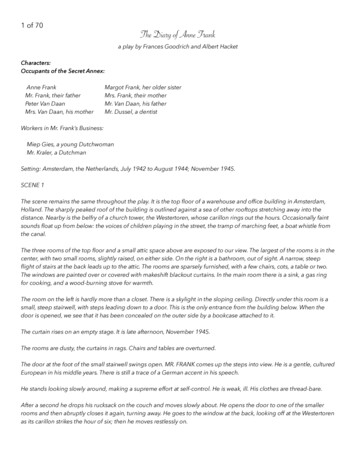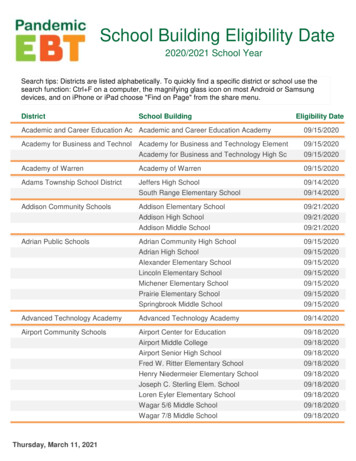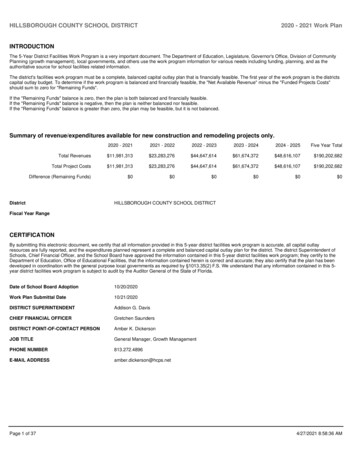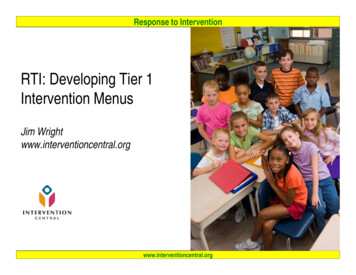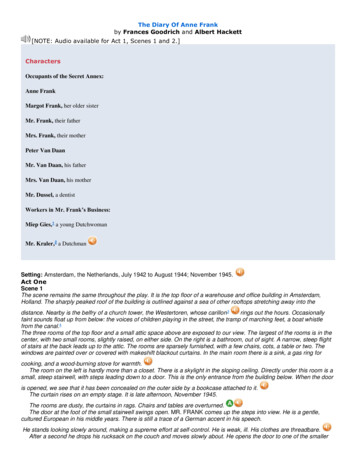
Transcription
MARY FRANK ELEMENTARYContinuous School Improvement Plan2020 - 2021The Mary Frank school community will educate children to be lifelong learners, academically andsocially-emotionally, through the combined efforts of parents, students, staff and community.“Learning for Life”1
MARY FRANK ELEMENTARYContinuous School Improvement Plan2020-2021Table of ContentsSection 1. Mary Frank Elementary School Improvement PlanContinuous School Improvement Committee Members3Introduction4-7Summary of Data7-10Parent Involvement10-11Technology as a Learning Tool11-13Safe and Orderly Environment13-15Cultural Competency15-16Professional Development16-17Career Awareness and Career Development PlanConclusions and Current Status of Educational Programming17-18Statutes and Rules to be waived18-1919Timeline for Implementation, Review, and Revision19Section 2. School Improvement Goal StrategiesGoal 1: K-2 English/Language Arts: Reading20-21Goal 2: 3-5 English/Language Arts21-22Goal 3: 3-5 Math23-242
SECTION 1Mary Frank Elementary SchoolContinuous School Improvement Committee Members2020 – 2021Christie HeerschopPrincipalLisa WetzelKindergarten Teacher & PHMTA RepresentativeJen Tobin1st Grade TeacherAndrea Dunn2nd Grade TeacherSusan Lestinsky3 rd Grade TeacherJill Coffman4th Grade Teacher & ParentLindsay Helman4th Grade Teacher & Parent3
MARY FRANK ELEMENTARY2020– 2021 Continuous School Improvement PlanIntroductionMary Frank Elementary School is one of 11 elementary schools in the Penn-Harris-Madison School Corporation. Our schoolis located in Granger, Indiana, a suburban setting of South Bend/Mishawaka in the northeast section of St. Joseph County.Enrollment for 2020-2021 is 479 students ranging from preschool through grade five. Faculty and staff personnel numberapproximately 69 (including part-time and full-time). Mary Frank Elementary houses five half-day typical and special needspreschool sessions (2-3 times a week) and a full-day Early Learning Academy for 4 year olds. Mary Frank does have specialpopulations including English Language Learners (2.0%) and Exceptional Education students (8.5%). The free and reduced rate atMary Frank has hovered around the same percentage over the years, and now rests at 18.5%.The Mary Frank curriculum follows a redesigned curriculum map which aligns with the newly revised “priority” and“high-priority” standards in grades 3 -5. These standards were revised to meet the rigor of the new state assessment: ILEARN.Teachers have collaborated, and will continue to meet throughout the year, to determine the most effective instructionalstrategies to address these standards. A copy of the curriculum maps are located on the Curriculum, Instruction, and AssessmentGoogle site within the PHM internal website, in classrooms, and in the main office of Mary Frank. Common planning time existsacross the grade levels, as well as scheduled meetings that are guided by the Teacher Leadership Team. Grade level teams alsomeet with the principal to analyze data, monitor student learning, and determine best practice when teaching students. Studentprogress toward those standards is provided quarterly to parents through the PHM report cards.Before they start school, kindergarten students are screened and identified for supplemental instruction. Students ingrades K - 2 are given Dynamic Indicators of Basic Early Learning Skills (DIBELS) and Text Reading Comprehension (TRC) 3 timesa year: beginning, middle, and end. Student performance in grades 3 – 5 is also measured with ClearSight interim assessmentstwice a year, and ClearSight formative assessments several times a year in reading, language, writing and mathematics. Starting4
in April, students in grades 3-5 take the state ILEARN to measure math and language arts performance. Students in grade 3 alsotake the IREAD 3 in March. Writing Assessments (also performance tasks) are given throughout the school year and are scoredby teachers using the statewide rubric. Math Mini assessments are also given to students throughout the school year. Otherassessments include SRI (Scholastic Reading Inventory), Kindergarten Screening, NWEA, CogAT, and IREAD (3rd grade only). Inaddition, teachers measure student mastery frequently with lesson embedded criterion-referenced assessments.Indiana instituted its letter grade system in 2011. During those years, Mary Frank held a grade letter “A” four consecutiveyears. In 2016-17, Mary Frank dropped to a “B” and in the 2017-18 school year, the letter grade remained a “B.” Performance dataon ISTEP has consistently remained above the state average. In 2018-19, performance in ILEARN, the new statewide assessment,indicated significant growth in proficiency and in the variance of performance from school performance and statewideperformance at the same grade level. It is significant to note that Mary Frank ranked #8 in the state in combined proficiency ofEnglish Language Arts (ELA) and Math in grades 3-5. This is in comparison to 507 other public elementary schools in the state ofIndiana. That data is represented below in the summary of the data section. Additionally, Mary Frank 3rd graders scored #1 and#2, respectively, in ELA and Math, in the state (using proficiency rate). At the time this document was published and provided tothe IDOE, school grades had not been awarded.School population data:SCHOOL CLASSROOM tyPopulation5 ( 1/2 Day 33Black2.4%1 st Grade7533Asian8.0%2 Grade72333 rd Grade7233Native AmericanMultiracial0.0%4.6%4 th Grade70335th Grade5322Early Learning Academynd ClassroomsSCHOOL ETHNICITY5
The Educational Programs are:ACADEMIC PROGRAMSSpell BowlWFME MorningAnnouncementsPrimary LiteracyGroupsProject Lead the WayPHYSICAL PROGRAMSSOCIAL/EMOTIONAL PROGRAMSReader Incentives5 th Grade Basketball IntramuralsAnti-Bully ProgramMobile Computer LabGirls on the RunYouth Service BureauRunning is ElementaryWeekly SEL lessonsPenn PALS CommunityPreschoolth K-5 Response toInstruction (RtI)Life Lines (Character Education)One School One BookRemedial Summer SchoolPHILANTHROPIC PROGRAMSGirls on the RunScreen Free WeekMindscapes Academic FairSt. Jude DriveLunch Bunch YSBYoung Authors’ConferenceEnrichment SummerAcademiesPHM Health & Wellness FairMustang of the QuarterHigh Ability InstructionMustangs Give BackStudent LeadershipService DrivesSt. Jude Math-a-thonMustangs Give Back & Merry MustangsMary Frank Life Goals(Do the right thing, Treat people right)Mary Frank Elementary Mission StatementMary Frank Elementary School educates children to be lifelong learners, academically and socially, through the combined effortsof parents, children, staff and the community.Motto“Learning for Life”Mission, Vision and BeliefsMary Frank Elementary School has aligned its mission, vision, and beliefs with those of the Penn-Harris-Madison SchoolCorporation. As an elementary school, our main focus is on helping all students perform at or above grade level in reading, math,and writing by the end of third grade.6
Mary Frank Life GoalsDo the Right Thing and Treat People RightSUMMARY of DATAThe school improvement team reviewed historical and current assessment data of student performance. A summary ofthis data was created by this team, and goals were established based upon the analysis of the available data. As new databecomes available, goals and strategies will be reviewed and adjusted to meet the needs of students, and guide teachers ininstructional planning. *Due to the status of Indiana schools in spring of 2019, the ILEARN and I-READ scores remain the same. ILEARN wascanceled due to the global pandemic of the novel Coronavirus (COVID-19).School AttendanceAttendance 018-201997%96.3%96.8%99.8%96.6%97.1%A review of the attendance records indicates a very high percentage of students attend school on a consistent basis. Asindicated above, the rate of attendance has remained higher than 96% for 5 consecutive years. Excessive tardiness and absencesare closely monitored with follow-up phone calls, and letters. On the rare occasion, referrals can be made to the CASIE Centerwhen absences are excessive, and school interventions have not shown to be effective.In 2020, the student attendance measures changed at the state level to reflect a measurement of “model attendees.” A“model attendee” is a student who is in attendance 96% of his or her enrolled days during the school year (persistent attendee); ora student who has improved his or her attendance by at least three percentage points from the prior to current school year(improving attendee). Student attendance measures whether students are considered “model attendees” by either demonstratingpersistent attendance or improved attendance during the school year. Mary Frank has an average of 79.1%, which is 13.8% higherthan the state average of 65.3%.7
ILEARN Spring 2020 Percentage of Students Passing*English/Language ArtsMathGrade 393%95%Grade 481%87%Grade 577%69%*Due to the status of schools in spring of 2019, the scores remain the same. ILEARN was canceled due to the Pandemic of the novel Coronavirus(COVID-19).ISTEP Historical data & Spring 2018 Percentage of Students Passing Both ELA & Math:Year201420152016State162017State172018State 183rd Grade97%84%86%54%81%53%92%53%4th Grade89%86%77%55%85%54%83%53%5th Grade98%73%86%54%69%54%86%53%GradeILEARN Variance for school to district and school to state passing rates:English Language ArtsISTEPILEARNMary FrankStateStateVariancePHMMF/PHMVarianceMary 0192018-20192018-20192018-20193rd Grade88%67%21%81%7%93%46%47%65%28%4th Grade85.00%64%21%82%3%81%45%36%69%12%5th Grade87.00%60%27%74%13%77%47%30%73%4%3-5 Average87%64%23%84%46%38%8
MathISTEPILEARNMary 2017-20182017-20182018-20192018-20192018-20193rd Grade96%59%37%78%18%95%58%37%74%21%4th Grade8061%19%80%0%87%53%34%76%11%5th Grade8266%16%79%3%69%47%22%71%-2%3-5 Average86%62%PHMMF/PHMVarianceMary -20192018-201953%31%DIBELS was given in K-2 nd grade until the 16-17 school-year. During the 17-18 school years only Kindergarten & 1 st gradestook the DIBELS test. 2 nd grade will take DIBELS again in the 18-19 school-year. DIBELS assesses students on a variety of skills andgives an overall instructional recommendation.TRC Historical data & Spring 2018 End of the Year (EOY) Percentage of Students at Grade LevelKindergarten GoalsDist. 16MFE 16Dist. 17MFE 17Dist. 18MFE 18Dist. 19MFE 19TRC Proficiency Level70717273667567781 st Grade GoalsDist. 16MFE 16Dist. 17MFE 17Dist. 18MFE 18Dist. 19MFE 19TRC Proficiency Level70497373694470639
2 nd Grade GoalsTRC Proficiency LevelDist. 16MFE 16Dist. 17MFE 17Dist. 18MFE 18Dist. 19MFE 197561NANANANA7972The analysis of student achievement on the ILEARN and other assessments used at Mary Frank indicate that our priorityareas for improvement should be centered on reading and math. Specifically, 3 goals are outlined with action steps in section 2.Goal 1: English/Language Arts: ReadingThe percentage of students demonstrating proficiency on Text Reading Comprehension (TRC) by the end of the year (EOY) willbe 80% for kindergarten, first, and second grade.Proficiency Levels :KindergartenC/D (EOY)1st GradeI (EOY)2nd GradeL/M (EOY)Goal 2: English/Language ArtsThe percentage of students of students in grades 3 - 5 passing ILEARN English/Language Arts will be 20 percent higher than thestate average.The overall pass rate of students in grades 3-5 passing ILEARN English/Language Arts in 2020 was 84%. The state pass rate ingrades 3-5 was 46%. This is a variance of 46%.*Due to the status of schools in spring of 2019, the scores remain the same. ILEARN was canceled due to the Pandemic of the novel Coronavirus(COVID-19).Goal 3: MathematicsThe percentage of students of students in grades 3 - 5 passing ILEARN Mathematics will be 20 percent higher than the stateaverage.The overall pass rate of students in grades 3-5 passing ILEARN Mathematics in 2020 was 84%. The state pass rate in grades 3-5was 46%. This is a variance of 38%.*Due to the status of schools in spring of 2019, the scores remain the same. ILEARN was canceled due to the Pandemic of the novel Coronavirus(COVID-19).10
PARENT INVOLVEMENTParent participation at Mary Frank has been and continues to be very high. The Mary Frank PTO is an integral part of ourschool. They support our staff and students by coordinating volunteers to run our “Art Smart” fine arts program; providingfinancial assistance for school field trips, classroom needs, and our Mindscapes (academic fair). The PTO offers additionalactivities for our families.The Mary Frank P.T.O and Mustang families support the following events and programs:Academic Programs:Art Smart; Mindscapes (Science, Social Studies, Arts Fair); Project Lead the Way (4 th ); Mustangs GiveBackEnvironmental Programs:Recycling Project (paper)Recognition Programs:5 th Grade Recognition, Birthday Recognition, Quarterly Positive Behavior AssembliesBack to School Night, Silent Auction/Sock Hop, Ice Cream Social, Mom & Muffins, Donuts With Dads,Movie Night; Screen Free WeekFamily Programs:The monthly Mustang Messenger is sent to parents electronically. Parents are informed of important dates and activities that aregoing on at Mary Frank. There is also an email set up to help parents communicate absences and transportation changes.TECHNOLOGY as a LEARNING TOOLAt Mary Frank Elementary School, students and staff use technology on a daily basis to help fulfill the expectations of ourindividual school improvement plan. Students and staff have access to one mobile lab, thirteen Chromebooks mobile carts (everyclassroom 1 st -5 th have a mobile cart) and one Samsung mobile cart for research in the IMC with 30 computers in each cart forgrades 1-5, one mini iPad mobile cart for every kindergarten classroom and other networked computers throughout the building(i.e.: Library) and 4th grade has a full iPad cart for Project Lead the Way. Teachers in grades K-2 also have access to their ownindividual iPad. Teachers K-5 have access to their laptop at both school and home. Teachers also have their own classroomprojectors and smart boards for interactive lessons that can be used with their iPad and/or laptop. Each teacher also has a soundprojection system in their classrooms.11
Computer programs are used to enhance instruction in a number of ways, among them are computer-generatedassessments designed to provide timely feedback on student achievement. At the kindergarten through second grade levels,DIBELS provides data for identifying students who need early interventions. Teachers of grades 3-5 gather data on students andmonitor their growth using ClearSight. Study Island, Reading Eggs, Reading Eggspress, Hearbuilder, Mindplay, Freckle,Flocabulary, IXL, and other educational software is available for grades K-5. This data helps teachers make decisions regardingflexible grouping to further target student needs. Teachers also have the ability to use their computers and projectors to showappropriate streaming videos through Learn 360, streaming our own studio news. This website allows teachers to search forvideos by Indiana State Standard, along with the topic, to pinpoint a skill taught in a specific lesson.Phonetic software is emphasized in grades K-2. Students use the program Hearbuilder to improve decoding skills. Studentsin grades 3-5 have access to keyboarding and word processing programs, such as Google Docs, to add a formal look to theirwriting. The ClearSight, Study Island, Front Row and the Edmentum software programs are used for students in grades K – 5 th .The ClearSight program and the multiple Edmentum programs allow teachers to create lesson folders that target areas wherestudents need additional support and or enrichment. Students also use technology to use the Internet for research and forprewriting activities. All computers have programs that include instructional reading, writing and math programs for elementarystudents. These programs are used as a component for differentiated learning centers.Teachers and staff have access to ClearSight, IXL, SRI, or DIBELS & TRC data online from their classroom station so theycan analyze their classroom data. They use the computers to access data analysis tools to study standardized test results,disaggregating them to find patterns which might indicate strategies to improve the progress of individual students and groups ofstudents with similar needs, assign standards based lessons to students, and to create their own formal assessments. Team orgrade level meetings are then devoted to the discussion of those strategies and any identified areas of concern. Teachers alsouse Scholastic Reading Inventory (SRI) Interactive which is a computer-adaptive assessment designed to measure how wellstudents read literature and expository texts of varying difficulties. This assessment instrument can be used as a diagnostic tool toplace students at the best level in the program so they can read with success.12
Teachers use eLearning which is an alternative to classroom instruction. With eLearning, students access their school workonline and complete the lessons outside the classroom. The IDOE has approved eLearning as a way to make up missed instructionon days when schools must close due to snow or other weather conditions. Google Classroom is an online program whereclasswork is posted. Teachers will be available via email and google messaging to answer questions and help students oneLearning days.In addition to integrating technology into instruction, we use technology for student and classroom management needs.Mary Frank Elementary has implemented a systematic program for teaching appropriate school behavior and rewardingstudents for making good behavior and learning choices. We use technology to guide our C.L.A.S.S. framework by showing videosto support our framework.The school corporation uses an electronic progress report program called Skyward. Teachers are able to enterassignments, link them to Indiana State Standards, and record children’s scores. The program takes those scores and figures a“grade” for each standard. Teachers are able to not only track student progress on a daily basis, but also keep track of their ownteaching through a visual reminder of what standards have and have not been taught.The corporation also uses an electronic evaluation program called Standards for Success. Teachers are able to view theirTeacher Evaluation Rubric scores, observations and download/attach artifacts that affect their Rubric score.SAFE & ORDERLY ENVIRONMENTA safe and orderly learning environment at Mary Frank is supported by the C.L.A.S.S. (Connected Learning Assures StudentSuccess) framework, as well as a focus on SEL (Social-Emotional Learning). The C.L.A.S.S. framework includes two life goals: Dothe Right Thing and Treat People Right. There are also monthly lifelines (character traits) which promote the idea of a commonvocabulary and a frame of reference for behavior and how we work together in the entire school community. Administrators,teachers, and students are constantly teaching, modeling, and assessing each other on the life lines and encouraging the use ofthe life lines beyond the school setting. In order to address the social and emotional needs of students from a proactive, positivestandpoint using research-validated best practices, all students will receive regular Tier 1 SEL lessons. The lessons have been13
aligned to both the Collaborative for Academic, Social and Emotional Learning (CASEL) and IN-DOE’s SEL core learningcompetencies, which include self-awareness/insight, self-management/regulation, relationship skills/collaboration, socialawareness/connection, responsible decision making/critical thinking, sensory-motor integration and mindset. Since stressmanagement is so critical for all students, there is a special focus on stress management multiple times throughout the course ofthe year. Information regarding the lesson topics and related information is communicated to school staff and parents on amonthly basis by the Director of SEL and Mental Health. The Tier 1 Lesson delivery framework is based off of a restorativepractice process of using community circles to help build relationships, community and a sense of belonging . The Youth ServicesBureau of St. Joseph County (YSB) works in partnership with all PHM Elementary Schools to provide a youth developmentspecialist in each building and this is the person who provides weekly lessons that promote the Indiana Social-Emotional LearningCompetencies. As SEL is a continued focus across the district, a school goal has been created and listed in section 2: SchoolImprovement Goal Strategies.“Mustang of the Quarter” is a student recognition program which encourages students to follow behavioral expectations.Classroom teachers recommend one student from their classroom each quarter who has demonstrated the Life Goals and lifelines of that quarter.A “Mustang of the Quarter” breakfast occurs quarterly and families are invited to participate in thatbreakfast with their students. Students have their pictures taken with their teacher, and receive a certificate of recognition.Mary Frank Elementary students, kindergarten through grade five, participate in both internet and anti-bullying safetyprograms. Lessons are required to be taught in the beginning of the school year, and revisited when necessary. The school alsohas access to programming through the Youth Service Bureau to supplement these efforts.The Mary Frank School Crisis Management (Safety) Plan is reviewed and updated annually. A crisis intervention team hasbeen identified for emergencies. Fire, storm, shelter in place, earthquake, and intruder drills are practiced routinely. Several staffmembers at Mary Frank are trained in CPR, first aid, hazardous waste and the use of an A.E.D. Additionally, training in Blood BornePathogens is required of all certified staff. All staff have two-way radios to communicate with the office. Severe weather andother local emergencies that might affect our elementary building are monitored by the principal and office staff using localweather radar and internet sites. The building has eight security cameras placed at a variety of entrance doors. Keypads provide14
Kids Club the opportunity for additional security during their hours of operation. All outside exit doors have letters to enhancedoor identification during emergencies. District initiatives further enhance safety at Mary Frank. Mary Frank has access to a resource officer at all times. EmergencyGo Bags are in place in any area of direct supervision of students. These bags hold student rosters as well as pertinent emergencyinformation. A dual safety protocol system is in place in our front entrance. The SafeVisitor system scans volunteers’ driverlicenses to see if a criminal record of crimes against children is present. Plastic film is in place on windows, making it more difficultto break glass and strategic panic buttons are also in place. A public address system code provides additional security via aschool-wide school announcement.CULTURAL COMPETENCYWe strive to increase the educational opportunities and performance for represented groups within our school. Our currentschool ethnic population is 80.0% White, 2.5% Hispanic, 2.0% Black, 8.0% Asian, and 4.5% Multiracial. Our current free and reducedlunch population is 18.5%. We have groups of identified High Ability students in grades 1-5 and Exceptional Education students ingrades K-5. We continue to initiate methods to improve the cultural competency of our students, parents, and staff.Penn-Harris-Madison School corporation created the position of Officer of Diversity, Equity, and Inclusion. The person inthis role will help promote and sustain a culture, consistent with the School Corporation’s mission to create a positive, healthylearning environment that embraces and celebrates diversity, equity, equality and inclusion of all students and staff. In order toassist with this new focus, Mary Frank has added a cultural awareness goal listed in section 2: School Improvement GoalStrategies.We recognize the need to identify and address the needs of our ELL student population. An Individual Learning Plan isdeveloped for each limited English proficient student. This document outlines specific accommodations and modificationsappropriate for all classroom instruction. Our students are serviced through sheltered classroom instruction and push-in/pull-outservices. Collaboration occurs between the mainstream teacher(s) and ELL staff to address areas of focus. WIDA standards15
addressed are Social and Instructional Language, which reflects the ways in which students interact socially to build communityand establish relationships with peers and teachers in ways that support learning. The remaining standards present ways studentscan communicate information, ideas, and concepts necessary for academic success. W-APT is given to incoming Kindergartenersidentified as living in a home where English is not the native language. We utilize LAS Links Assessment to determine fluency.Students are assessed using ACCESS one time per year.Our Exceptional Education staff members, teachers, and general education teachers work closely to implement IEPs andincrease student academic performance. Identified High Ability students are cluster grouped, and teachers receive assistancefrom a district High Ability Coordinator to plan instruction as needed. Staff development is offered by the High Ability Coordinator.We are dedicated to continuing to develop new strategies and utilizing best practices previously identified. Frequent assessmentsare used to differentiate instruction for all learners.Our school staff and PTO coordinate seasonal celebrations such as Moms and Muffins, Donuts With Dads, Monthly Birthdaycelebrations, Screen Free Week events, Mindscapes Academic Fair and ice-cream social, Silent Auction/Sock Hop, Movie Nights,Fall, Winter, and Friendship parties. These events are opportunities to engage socially without boundaries that sometimes existbetween cultures. Mary Frank Elementary School celebrates the various cultures represented by our student population.PROFESSIONAL DEVELOPMENT The Mary Frank professional development focus is based on supporting staff to ensure they have the necessary skills andknowledge to support the achievement of the identified goals in English/Language Arts and Math. The overall goals for theprofessional development programs include: Increased achievement in English/Language Arts and Math The continued implementation of a support structure for teachers to implement research-based instructional strategies. Utilization of internal and external expertise to support the professional development plan16
Action Plan to Meet Goals:ActivityTeacherLeadership Teams(TLT)Intended imelineResourcesCertified TeachersAdministratorTLT membersDistrict supportWeekly/OngoingCurriculum maps,data, professionalarticles (library),other professionalmaterials asneededTech TalksCertified Teachers“Just Tech About It”(weekly newsletter)AdministratorTeachersTechnologyDistrict rialsMustang MindsetMeetings(collaboration)Certified TeachersAdministratorTLT membersDistrict Supportbi-weeklySee TLT ResourcesStaff professionaldevelopmentCertified Teachersand other Staff asneeded.AdministratorDistrict Support asneeded5 requiredprofessionaldevelopmentsessions of theteacher’s choosingTBD as neededImplementation ofGuided mathCertified TeachersDistrict PersonnelAdministratorModel Classroomsand experiencedteachersDaily/ongoing byteachersimplementing sional leavetime for PDPerformance TasksStrategy BuildingCertified TeachersAdministratorTeachersDistrict SupportOngoingProfessionaldevelopmentmaterials17
Professional leavetime for PDMonthly Data &InstructionMeetingsCertified Teachers(in grade g onneed)TBD as neededOther professional development areas include co-teaching, technology, and school law. These are areas offered at thedistrict level for teachers. The district will also continue to offer staff CPI (Nonviolent Crisis Prevention and Intervention) training forCrisis Teams and individual staff members who work with students needing additional behavior support.Career Awareness and Career Development PlanFor grades one through five, we instill a lifelong learning model that demonstrates a willingness to work and learn to applynew knowledge. We use learning strategies to guide critical thinking skills through decision-making. We teach self-discipline byutilizing centers in our classrooms. This helps our students have a strong work ethic and promotes independence. Our school usesSocial and Emotional skills for regulation and collaboration. Social Emotional Learning (SEL) lessons are taught throughout gradesK-5 to help recognize and manage emotions. B ased on research especially regarding neurodevelopment and culturalresponsiveness, the Indiana Department of Education holds that there are seven core competencies (Insight, Regulation,Connection, Collaboration, Critical Thinking, Sensory-Motor Integration, & Mindset), which can be broken down into subtopics.These core competencies need to be intentionally taught to students to help them be successful both now and in the future. Theseskills help our students with career awareness and introduce our students to work values and basic employment concepts. A
MARY FRANK ELEMENTARY Continuous School Improvement Plan 2020-2021 Table of Contents Section 1. Mary Frank Elementary School Improvement Plan C o n t i nu o u s S ch o o l I mp ro v em en t Comm ittee M em ber s 3 I n t r o du c t i o n 4-7 S u m m a r y o f D a ta 7-10 P a r e nt In volv eme n t 10-1 1
